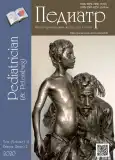Aspiration lipoid pneumonia in a child 1.5 years
- Authors: Budarova K.V.1,2, Shmakov A.N.2, Bokut V.A.1, Makarova D.Y.1, Polonskaya M.A.1, Uspenskaya S.V.1
-
Affiliations:
- City Children’s Clinical Emergency Hospital
- Novosibirsk State Medical University Hospital
- Issue: Vol 11, No 2 (2020)
- Pages: 85-92
- Section: Reviews
- URL: https://journals.rcsi.science/pediatr/article/view/120348
- DOI: https://doi.org/10.17816/PED11285-92
- ID: 120348
Cite item
Full Text
Abstract
Aspirated lipoid pneumonia is a rare lung disease, in which interstitial lesion with chronic respiratory failure is predominantly expressed. In the available literature, this pathology is described in the form of separate observations with an empirical selection of therapeutic measures. The appearance of lipophages in a bronchial aspirate is recognized as a pathognomonic sign of lipoid pneumonia. There is no etiological treatment of the disease. The effectiveness of intensive therapy, according to available sources, depends on the severity of respiratory failure and on the timing of the start of complex bronchodrainage therapy, and theoretically the most attractive is kinesitherapy. Only one observation describes the use of bronchial lavage with sequential separate intubation of the main bronchi. Hormone therapy is considered effective, but the physiological basis for its use is not presented. The published observation is characterized by a late start of treatment due to a long diagnostic search. The applied therapeutic measures are given and described in detail with an assessment of the expected and achieved practical benefits. It was shown that beneficial effects were due to the use of bronchodrainage therapy techniques, including the jet high-frequency artificial ventilation of the lungs. There are doubts about the appropriateness of the use of corticosteroids in this pathology.
Full Text
##article.viewOnOriginalSite##About the authors
Kristina V. Budarova
City Children’s Clinical Emergency Hospital; Novosibirsk State Medical University Hospital
Author for correspondence.
Email: bcv@yandex.ru
Anesthesiologist, Intensive Care Unit; MD, PhD, Associate Professor, Department of Anesthesiology and Intensive Care, Faculty of Medicine
Russian Federation, NovosibirskAleksey N. Shmakov
Novosibirsk State Medical University Hospital
Email: alsmakodav@yandex.ru
MD, PhD, Dr Med Sci, Professor, Department of Anesthesiology and Intensive Care
Russian Federation, NovosibirskVladimir A. Bokut
City Children’s Clinical Emergency Hospital
Email: ORIT2231420@mail.ru
Head of Intensive Care Unit, Anesthesiologist, Intensive Care Unit
Russian Federation, NovosibirskDiana Yu. Makarova
City Children’s Clinical Emergency Hospital
Email: ORIT2231420@mail.ru
Anesthesiologist, Intensive Care Unit
Russian Federation, NovosibirskMariya A. Polonskaya
City Children’s Clinical Emergency Hospital
Email: ORIT2231420@mail.ru
Anesthesiologist, Intensive Care Unit
Russian Federation, NovosibirskSvetlana V. Uspenskaya
City Children’s Clinical Emergency Hospital
Email: ORIT2231420@mail.ru
Anesthesiologist, Intensive Care Unit
Russian Federation, NovosibirskReferences
- Морозова Л.В., Ермилов О.В., Бочарова М.А., Волочаева Е.М. Липоидная пневмония: клинический случай // Научные ведомости Белгородского государственного университета. Серия: медицина. Фармация. – 2015. – № 16. – 272–276 с. [Morozova LV, Ermilov OV, Bocharova MA, Volochaeva EM. Lipoidnaya pnevmoniya: klinicheskiy sluchay. Belgorod State University scientific bulletin. Medicine, pharmacy. 2015;(16):272-276. (In Russ.)]
- Al-Kindi H, Abdoani R, El-Iraqi M, Praseeda I. Lipoid Pneumonia Following Aspiration of Ghee (animal fat) in an Omani Infant. Oman Med J. 2008;23(2):108-111.
- Hadda V, Khilnani GC. Lipoid pneumonia: an overview. Expert Rev Respir Med. 2010;4(6):799-807. doi: 10.1586/ers.10.74.
- Sias SM, Ferreira AS, Daltro PA, et al. Evolution of exogenous lipoid pneumonia in children: clinical aspects, radiological aspects and the role of bronchoalveolar lavage. J Bras Pneumol. 2009;35(9):839-845. doi: 10.1590/s1806-37132009000900004.
- Tukaram SJ, Sastry SDS, Mehta RM. Bronchoscopic Segmental Lavage for Refractory Lipoid Pneumonia in a Toddler. J Bronchology Interv Pulmonol. 2018;25(2): e19-e21. doi: 10.1097/LBR.0000000000000436.
- Stathis G, Priftis KN, Moustaki M, Alexopoulou E. Non-resolving Findings in a Long-term Radiographic Follow-up of an Infant with Acute Paraffin Oil Aspiration. J Clin Imaging Sci. 2014;4:2. doi: 10.4103/2156-7514.126028.
Supplementary files














